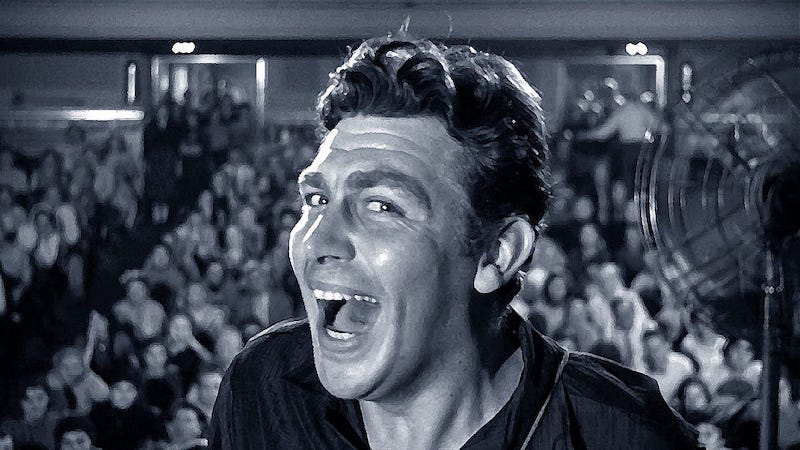On May 28, 1957, the American film industry saw the release of “A Face in the Crowd,” a drama that would not only mark the debut of several soon-to-be major Hollywood stars but also put the small town of Piggott, Arkansas, on the map. Directed by Elia Kazan and based on Budd Schulberg’s short story “Your Arkansas Traveler,” the film presents a compelling narrative rooted in the heart of northeast Arkansas.

The Film’s Origins
“A Face in the Crowd” traces its origins to Schulberg’s story, which was first published in the 1953 anthology Some Faces in the Crowd. The narrative centers around a fictional Arkansas native, Larry “Lonesome” Rhodes, whose meteoric rise from a small-town drifter to a manipulative media sensation serves as a cautionary tale about the power of television and charismatic personalities.
Schulberg, who had previously collaborated with Kazan on the Academy Award-winning “On the Waterfront,” was keen to bring this story to the big screen. Together, they crafted a screenplay that stayed true to the essence of the original story while adding the cinematic flair that Kazan was known for.
Piggott, Arkansas: The Chosen Location
One of the film’s distinguishing features is its authentic portrayal of Arkansas life. The opening scenes are set in northeast Arkansas, with filming on location in Piggott, a small town in Clay County. This choice was pivotal in grounding the story in a real, tangible setting. Kazan’s decision to film in Piggott brought Hollywood glamour to rural Arkansas and provided local residents with the unique opportunity to serve as extras in a major motion picture.
Piggott’s local citizens embraced the filmmakers, and many of them can be seen throughout the film, lending an air of authenticity that might not have been possible with seasoned actors alone. This engagement with the community also left a lasting legacy in the town, remembered fondly by those who participated.
A Star-Studded Debut
“A Face in the Crowd” is notable for marking the screen debut of Andy Griffith, who plays the lead role of Larry “Lonesome” Rhodes. Griffith’s transition from a relatively unknown performer to a household name began with this film. His portrayal of Rhodes, a complex character who charms his way to the top while revealing a darker side, showcased Griffith’s versatility and set the stage for his future success in television and film.
The film also introduced audiences to Lee Remick, who made her debut as Betty Lou Fleckum, a baton-twirling teenager who becomes one of Rhodes’s romantic interests. Remick’s performance, marked by both innocence and ambition, hinted at the illustrious career she would go on to have.
In addition to Griffith and Remick, the film featured early significant roles for Walter Matthau and Tony Franciosa. Matthau played the cynical writer Mel Miller, who sees through Rhodes’s charm and manipulations, while Franciosa took on the role of Joey DePalma, a savvy, ambitious agent. Both actors delivered performances that would help cement their reputations in Hollywood.
Cultural Impact and Legacy
Upon its release, “A Face in the Crowd” received mixed reviews but has since gained recognition as a prescient and powerful film that foreshadowed the influence of television and media in shaping public opinion and political landscapes. Kazan’s direction and Schulberg’s incisive script combined to deliver a critique of media’s potential for manipulation that remains relevant today.
The film’s Arkansas setting and the involvement of local residents provided a unique backdrop that enriched the narrative and added a layer of authenticity. For the people of Piggott, the film remains a cherished part of their local history, a time when their town played host to Hollywood and its magic.
A Lasting Legacy
In the decades since its release, “A Face in the Crowd” has become more than just a film; it’s a cultural touchstone that presciently explored the power dynamics of media and celebrity. Its Arkansas roots, highlighted through the authentic setting and the involvement of Piggott’s residents, add depth and character to the film’s narrative.
As we reflect on the impact of “A Face in the Crowd,” it is clear that this film transcends its era, continuing to offer insights into the media’s role in society. For Arkansas, and especially for the town of Piggott, the film’s legacy endures as a symbol of how even the smallest places can leave a lasting mark on the cultural landscape. This intersection of local charm and Hollywood grandeur ensures that “A Face in the Crowd” will always hold a special place in the annals of both film history and Arkansas heritage.


